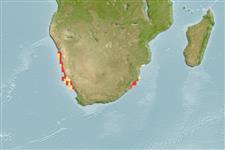>
Eupercaria/misc (Various families in series Eupercaria) >
Sparidae (Porgies)
Etymology: Lithognathus: Greek, lithos = stone + Greek, gnathos = jaw (Ref. 45335).
More on author: Cuvier.
Environment: milieu / climate zone / depth range / distribution range
Ecología
marino; salobre bentopelágico; anfidromo (Ref. 51243); rango de profundidad ? - 150 m (Ref. 27121). Subtropical; 22°S - 31°S
Southeast Atlantic: known only from the Orange River mouth to Natal, South Africa.
Length at first maturity / Tamaño / Peso / Age
Maturity: Lm 54.0 range ? - ? cm
Max length : 200 cm TL macho / no sexado; (Ref. 3198); common length : 65.0 cm TL macho / no sexado; (Ref. 3507)
Short description
Claves de identificación | Morfología | Morfometría
Espinas dorsales (total) : 11; Radios blandos dorsales (total) : 10; Espinas anales: 3; Radios blandos anales: 8. Silvery in color, crossbars fade with age.
Found over sandy substrate, in estuaries and oceanic waters. Enters lagoons (Ref. 3198). Feeds bottom invertebrates, including worms, crabs and shrimp (Ref. 27121). Spawns in the sea but uses estuaries as nursery grounds. Prime angling fish. Important food fish. Sold fresh and whole in markets.
Life cycle and mating behavior
Madurez | Reproducción | Puesta | Huevos | Fecundidad | Larva
Bauchot, M.-L. and M.M. Smith, 1984. Sparidae. In W. Fischer and G. Bianchi (eds.) FAO species identification sheets for fishery purposes. Western Indian Ocean (Fishing Area 51). volume 4. [var. pag.] FAO, Rome. (Ref. 3507)
IUCN Red List Status (Ref. 130435: Version 2024-1)
Threat to humans
Harmless
Human uses
Pesquerías: escaso valor comercial; pesca deportiva: si
Herramientas
Special reports
Download XML
Fuentes de Internet
Estimates based on models
Preferred temperature (Ref.
123201): 12.5 - 24.1, mean 15.7 °C (based on 28 cells).
Phylogenetic diversity index (Ref.
82804): PD
50 = 0.5625 [Uniqueness, from 0.5 = low to 2.0 = high].
Bayesian length-weight: a=0.01549 (0.00939 - 0.02556), b=3.04 (2.90 - 3.18), in cm total length, based on LWR estimates for this species & (Sub)family-body (Ref.
93245).
Nivel trófico (Ref.
69278): 3.1 ±0.1 se; based on diet studies.
Generation time: 10.9 ( na - na) years. Estimated as median ln(3)/K based on 1
growth studies.
Resiliencia (Ref.
120179): Bajo, población duplicada en un tiempo mínimo de 4.5-14 años (K=0.1).
Fishing Vulnerability (Ref.
59153): High to very high vulnerability (72 of 100).
Climate Vulnerability (Ref.
125649): Very high vulnerability (78 of 100).
Nutrients (Ref.
124155): Calcium = 24.8 [12.9, 45.8] mg/100g; Iron = 0.664 [0.364, 1.136] mg/100g; Protein = 18.5 [16.9, 20.3] %; Omega3 = 0.302 [0.191, 0.497] g/100g; Selenium = 45.7 [21.7, 85.5] μg/100g; VitaminA = 6.95 [2.03, 19.38] μg/100g; Zinc = 0.722 [0.505, 1.031] mg/100g (wet weight);
